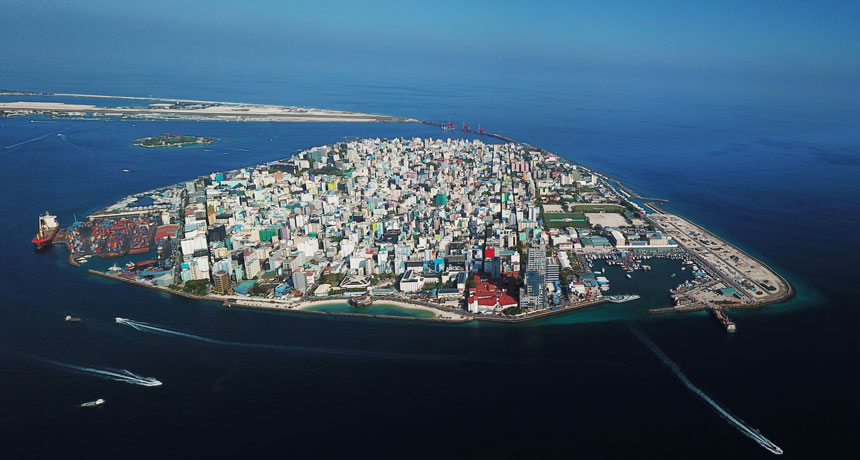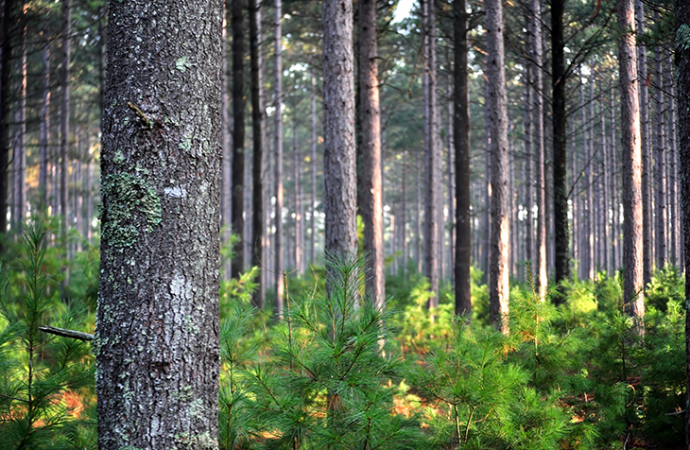Half a degree can make a world of difference
Limiting global warming to 1.5 degrees Celsius versus 2 has big benefits, the IPCC says

Due to impending sea level rise, this island nation in the Indian Ocean — the Maldives — is among the most threatened anywhere by climate change.
SHAHEE ILYAS/WIKIMEDIA COMMONS (CC BY-SA 3.0)
The average temperature of the planet has been rising since the 1700s and its Industrial Revolution. Three years ago, in 2015, 195 nations signed onto what is known as the Paris Accord. In it, they agreed to curb greenhouse gas emissions to limit that warming by 2100. The goal is not to let it exceed 2 degrees Celsius (3.6 degrees Fahrenheit) over preindustrial times. But a new report says there may be big benefits to setting an even lower target.
If Earth warms by just 1.5 degrees C (2.7 degrees F), we would see fewer life-threatening extremes in heat, drought and precipitation. There also would be less sea level rise and fewer species would go extinct.
The new report comes from the Intergovernmental Panel on Climate Change, or IPCC. A summary of its full report came out October 8. It followed a weeklong meeting of scientists and policy makers in Incheon, South Korea. “This will be one of the most important meetings in the IPCC’s history,” said Hoesung Lee in his opening address. He spoke on October 1. He is a climate economist who works at Korea University in South Korea. He’s also the current IPCC chair.
For their report, scientists sifted through more than 6,000 papers. Those papers probed the impact of a global warming of 1.5 degrees. Sometimes the scientists even worked through the night, says Natalie Mahowald. She’s a climate scientist at Cornell University in Ithaca, N.Y. She’s also one of the report’s coauthors. The long hours were worth it. The report’s message is compelling and urgent, she says. “Such a small change in temperature will have big impacts on people.”
Curbs called for in the Paris Accord were designed to keep global warming to “well below” 2 degrees by 2100. Getting all the delegates to agree on that was hard. But many scientists have warned that this limit isn’t good enough. It won’t halt major environmental changes. And it could affect everything from sea level rise and water scarcity to habitat loss.
During the Paris talks, more than 100 nations called for a lower target — 1.5 degrees Celsius. Those nations included many of the countries at greatest risk from climate change. Examples are the Indian Ocean island nation of the Maldives and drought-stricken Angola in Africa.
Until very recently, scientists knew relatively little about how the risks from a 1.5-degree warming would differ from those due to a warming of 2 degrees. (Lee noted this in his October 1 address.) So the nations invited the IPCC to prepare a report to study that. Creating that report was a part of the decision to adopt the Paris Accord.

1.5 degrees versus 2
The two warming targets would lead to very different changes. They are outlined in the new report. By reducing the warming to 1.5 degrees, people would experience fewer extremes in heat, rain and drought. A half a degree less warming also would shave an average of about 0.1 meter (4 inches) from sea-level rise by 2100. That would expose 10 million fewer people to related risks. These include flooding, infrastructure damage and saltwater breakthrough into freshwater resources.
There are great ice sheets in Antarctica and Greenland. Somewhere between 1.5 degrees and 2 degrees, these ice sheets could become very unstable. Their melting would further increase the potential for sea level rise. The Arctic Ocean is projected to be ice-free during the summer only once per century with just a 1.5-degree warming. That would increase to once a decade under the 2-degree scenario.
There also would be benefits for plants and animals with a lower rise in temperature, the report notes. Less habitat would be lost for many species compared with 2 degrees of warming. Other climate risks to species also would be milder. Among those risks: forest fires and the spread of invasive species.
Many of the data analyzed in the report come from scientific papers published only in the past two years. They weren’t available when the Paris Accord was signed. The London-based website Carbon Brief published an interactive infographic on October 4. It summarizes the results of 70 such 1.5-degree studies. They show the impacts of warming targets on everything from sea level and heatwaves to hurricanes.
Not an easy path
Despite building a case for a lower-temperature target, the trick will be how to get there. In 2017, the Paris Accord faced a major setback. That’s when President Donald Trump announced that the United States would pull out of the agreement. The United States is a major source of the greenhouse gases that drive warming. That makes hopes for achieving a far more stringent target especially daunting.
Scientists have examined various possible paths to limit the environmental harm due to warming. But almost all such paths share one thing in common, says Zeke Hausfather. He’s a climate scientist with Carbon Brief. They overshoot the 1.5-degree limit somewhere around the year 2050. Later, he says, they bring temps “back down.”
To overshoot the mark by only a small amount, or not at all, requires cutting emissions of greenhouse gases by a lot. That pollution would have to drop by about 45 percent compared to emissions in 2010. And that has to be done fast — in 11 years, or by 2030.
The IPCC wants nations of the world to reach “net zero” emissions of greenhouse gases by around 2050. To do that, technologies must be in place that pull greenhouse gases out of waste streams or the atmosphere at rates equal to what goes in. The result: The atmosphere receives no increase in warming gases. Even better would be to remove more greenhouse gases than are entering the atmosphere. Then overall levels of warming could fall.
If the overall limit on warming is just “below 2 degrees Celsius,” emissions by 2030 would need to decline less than half as much as for the 1.5 degree limit. And they could reach net zero up to 25 years later — by about 2075.
If such early, deep cuts don’t happen, “negative emissions” will be necessary. Negative emissions are, essentially, a hoped-for reduction in emissions. And they might bring temperatures back down after overshooting the mark mid-century. But to remove enough CO2 from the atmosphere to reverse the greenhouse effect would require new technologies.
Those might include carbon capture and storage. Some such so-called “hacks” exist. Today, however, these technologies are too costly to be put in place widely. And reversing the effects of greenhouse warming is not easy. “By and large,” Hausfather says, there’s a rather straight relationship between warming and growing levels of carbon dioxide in the atmosphere. “But once you start sucking [carbon dioxide] out of the atmosphere, that linear relationship breaks.” The fall in emissions must be greater than the growth in pollution had been that led to those elevated temps in the first place.
It’s uncertain how — or if — society will be able to use the new report’s findings to reshape the climate accords. During the 2015 Paris talks, a proposed 1.5-degree target was met with strong resistance from big polluter nations, particularly China. And President Trump’s administration has stated that the deep cuts needed in greenhouse-gas emissions are too costly and not yet ready to implement.
That is one reason the 1.5-degree goal may seem daunting. But this IPCC report — and the two years of intense research that led up to it — has also forced scientists to review some ideas about what’s possible, says Kaisa Kosonen. She works in Helsinki, Finland, as a climate policy adviser for Greenpeace International. She traveled to South Korea for the IPCC meeting. Investing in things such as better energy efficiency may one day lead to “results you didn’t know even existed,” she says. “I’ve been inspired by how much optimism there still is among scientists.”
Indeed, one of the key messages from the report is that holding warming to 1.5 degrees “is not impossible,” Mahowald says. “But it will require really ambitious efforts. And the sooner the better. We have to start cutting emissions now,” she says. “We have to be very ambitious on sustainable energy and sustainable agriculture.” What’s more, she notes, making this happen will require people to change their behaviors, too. These range from conserving energy to eating different foods.
But people also would face huge adjustments in a world that’s 2 degrees warmer, or even higher, she warns. So despite the challenges, Mahowald points out, “it still might be easier to reach 1.5 than to adapt to those higher temperatures.”
Correction: This article has been edited to note that the Maldives are in the Indian Ocean, not the Pacific.







